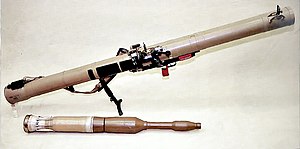| RPG-29 | |
|---|---|
 RPG-29 launcher with PG-29V rocket | |
| Type | Rocket-propelled grenade |
| Place of origin | Soviet Union |
| Service history | |
| In service | 1989–present |
| Used by | See Operators |
| Wars | War in Afghanistan (2001–2021) Iraq War[1] 2006 Lebanon War Syrian Civil War[2] 2014 Gaza War War in Iraq (2013–2017) Israel–Hamas war |
| Production history | |
| Designer | Bazalt |
| Designed | late 1980s |
| Manufacturer | Bazalt[3] |
| Produced | 1989 |
| Specifications | |
| Mass | 12.1 kg (27 lb) unloaded (with optical sight) 18.8 kg (41 lb) loaded (ready to fire) |
| Length | 1 m (3 ft 3 in) (dismantled for transport) 1.85 m (6 ft 1 in) (ready to fire) |
| Cartridge | PG-29V tandem rocket TBG-29V thermobaric rounds |
| Caliber | 105 mm (4.1 in) barrel 65 and 105 mm (2.6 and 4.1 in) warheads |
| Rate of fire | 2 rounds per minute |
| Muzzle velocity | 280 m/s (920 ft/s) |
| Effective firing range | 500 m (1,600 ft) 800 m (2,600 ft) (with tripod and fire control unit)[4] |
| Sights | Iron, optical, and night sights available with ranges up to 450 m (1,480 ft); automated day and day-night sights with laser rangefinder[4] |
| Blast yield | 750 mm (30 in) RHA 650 mm (26 in) RHA after ERA 1,500 mm (59 in) Reinforced concrete 3,700 mm (150 in) Log and earth fortification |
The RPG-29 "Vampir" is a Soviet reusable rocket-propelled grenade (RPG) launcher. Adopted by the Soviet Army in 1989, it was the last RPG to be adopted by the Soviet military before the fall of the Soviet Union in 1991.
The RPG-29 has since been supplemented by other rocket-propelled systems, such as the RPG-30 and RPG-32.
- ^ Cite error: The named reference
HezbollahinIraqwas invoked but never defined (see the help page). - ^ "La 104ème brigade de la Garde républicaine syrienne, troupe d'élite et étendard du régime de Damas". France-Soir (in French). 20 March 2017. Archived from the original on 19 October 2017. Retrieved 4 September 2018.
- ^ "The World Market for Man-Portable Anti-Armor and Bunker Buster Weapons" (PDF). forecastinternational.com. Retrieved 7 July 2023.
- ^ a b Russian Close Combat Weapon. Moscow: Association "Defense Enterprises Assistance League". 2010. pp. 444–447. ISBN 978-5-904540-04-3.